Report: Finance for Strategic Managers - NHS Financial Decision Making
VerifiedAdded on 2019/12/04
|15
|4784
|37
Report
AI Summary
This report provides a comprehensive analysis of finance for strategic managers, specifically within the context of the National Health Service (NHS). It begins by assessing the need for financial information in business operations, emphasizing its role in raising finance, supporting investment decisions, setting targets, managing risks, and satisfying stakeholder needs. The report then explores various business risks related to financial decisions, including market, operational, and compliance risks, and their potential impact on the NHS. It further outlines the financial information required for making strategic business decisions, such as income and expenditure, cash flow, and cash projections. The report also examines the purpose, structure, and content of published accounts, including formats like income statements and balance sheets, and how financial information can be interpreted using tools like ratio analysis. It discusses both long and short-term financial requirements, sources of finance, and cash flow management techniques. Additionally, the report covers business ownership structures, managerial roles in decision-making, and the evaluation of strategic capital or investment projects, including capital budgeting techniques. Overall, the report offers insights into how financial management supports strategic decision-making within the NHS.
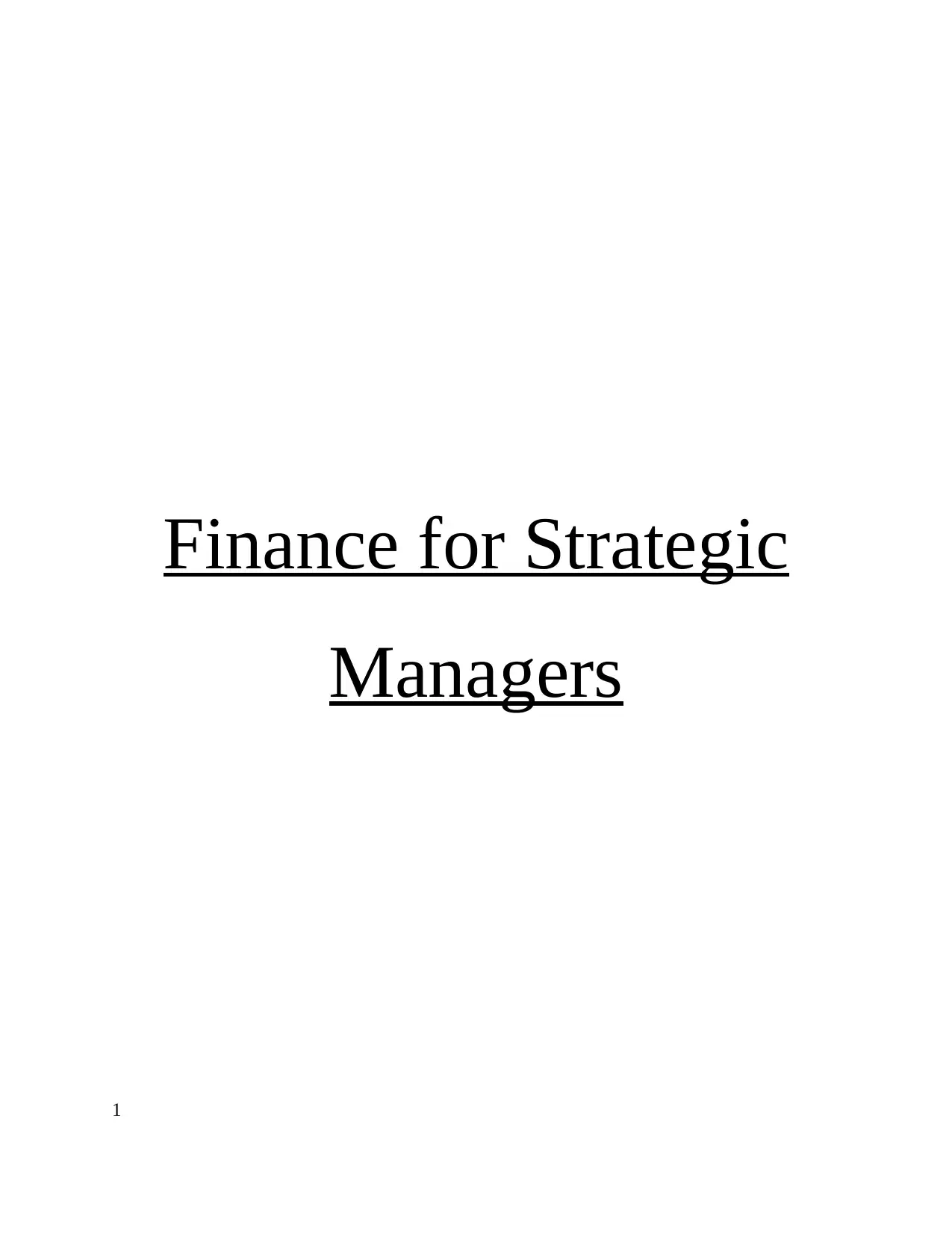
Finance for Strategic
Managers
1
Managers
1
Paraphrase This Document
Need a fresh take? Get an instant paraphrase of this document with our AI Paraphraser
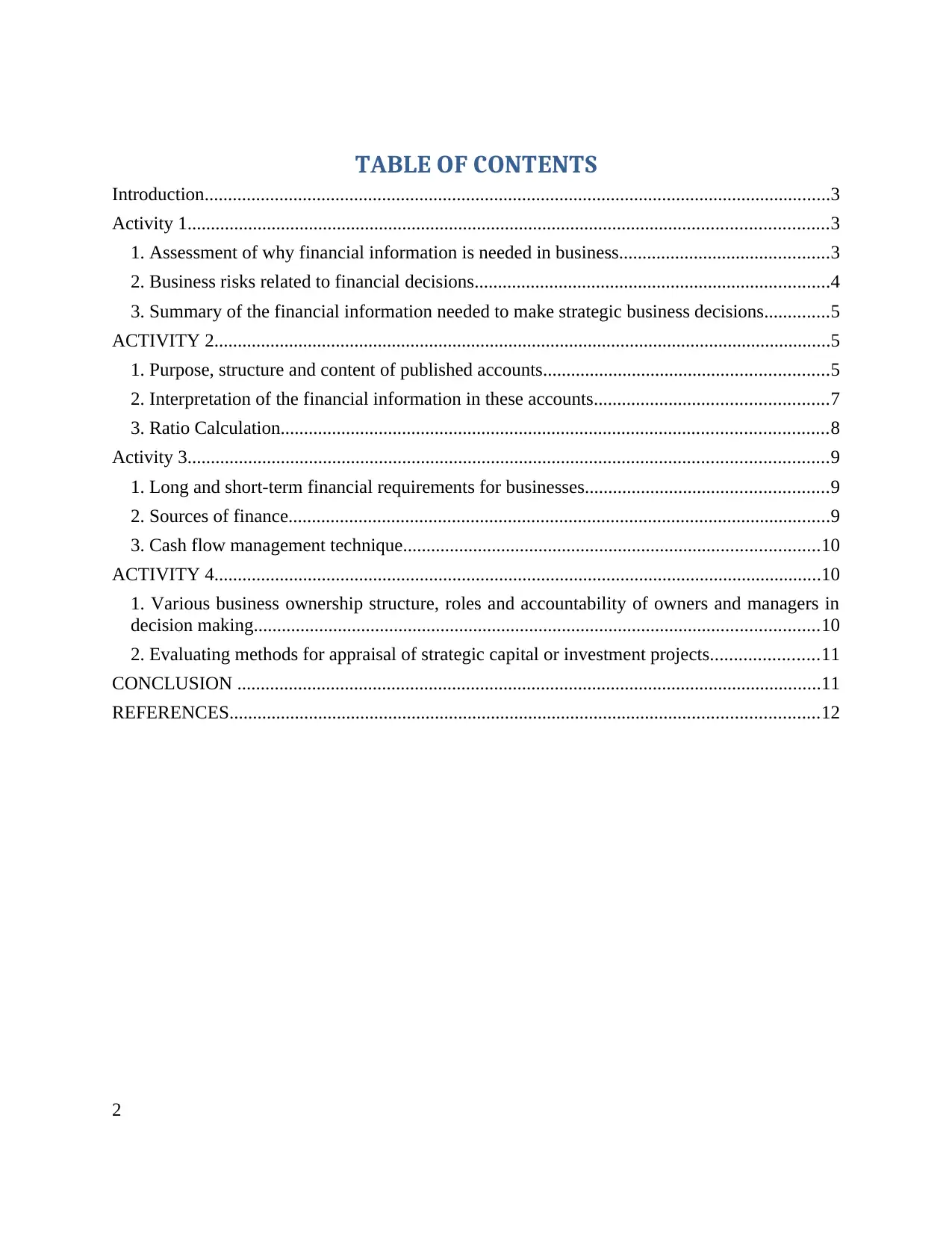
TABLE OF CONTENTS
Introduction......................................................................................................................................3
Activity 1.........................................................................................................................................3
1. Assessment of why financial information is needed in business.............................................3
2. Business risks related to financial decisions............................................................................4
3. Summary of the financial information needed to make strategic business decisions..............5
ACTIVITY 2....................................................................................................................................5
1. Purpose, structure and content of published accounts.............................................................5
2. Interpretation of the financial information in these accounts..................................................7
3. Ratio Calculation.....................................................................................................................8
Activity 3.........................................................................................................................................9
1. Long and short-term financial requirements for businesses....................................................9
2. Sources of finance....................................................................................................................9
3. Cash flow management technique.........................................................................................10
ACTIVITY 4..................................................................................................................................10
1. Various business ownership structure, roles and accountability of owners and managers in
decision making.........................................................................................................................10
2. Evaluating methods for appraisal of strategic capital or investment projects.......................11
CONCLUSION .............................................................................................................................11
REFERENCES..............................................................................................................................12
2
Introduction......................................................................................................................................3
Activity 1.........................................................................................................................................3
1. Assessment of why financial information is needed in business.............................................3
2. Business risks related to financial decisions............................................................................4
3. Summary of the financial information needed to make strategic business decisions..............5
ACTIVITY 2....................................................................................................................................5
1. Purpose, structure and content of published accounts.............................................................5
2. Interpretation of the financial information in these accounts..................................................7
3. Ratio Calculation.....................................................................................................................8
Activity 3.........................................................................................................................................9
1. Long and short-term financial requirements for businesses....................................................9
2. Sources of finance....................................................................................................................9
3. Cash flow management technique.........................................................................................10
ACTIVITY 4..................................................................................................................................10
1. Various business ownership structure, roles and accountability of owners and managers in
decision making.........................................................................................................................10
2. Evaluating methods for appraisal of strategic capital or investment projects.......................11
CONCLUSION .............................................................................................................................11
REFERENCES..............................................................................................................................12
2
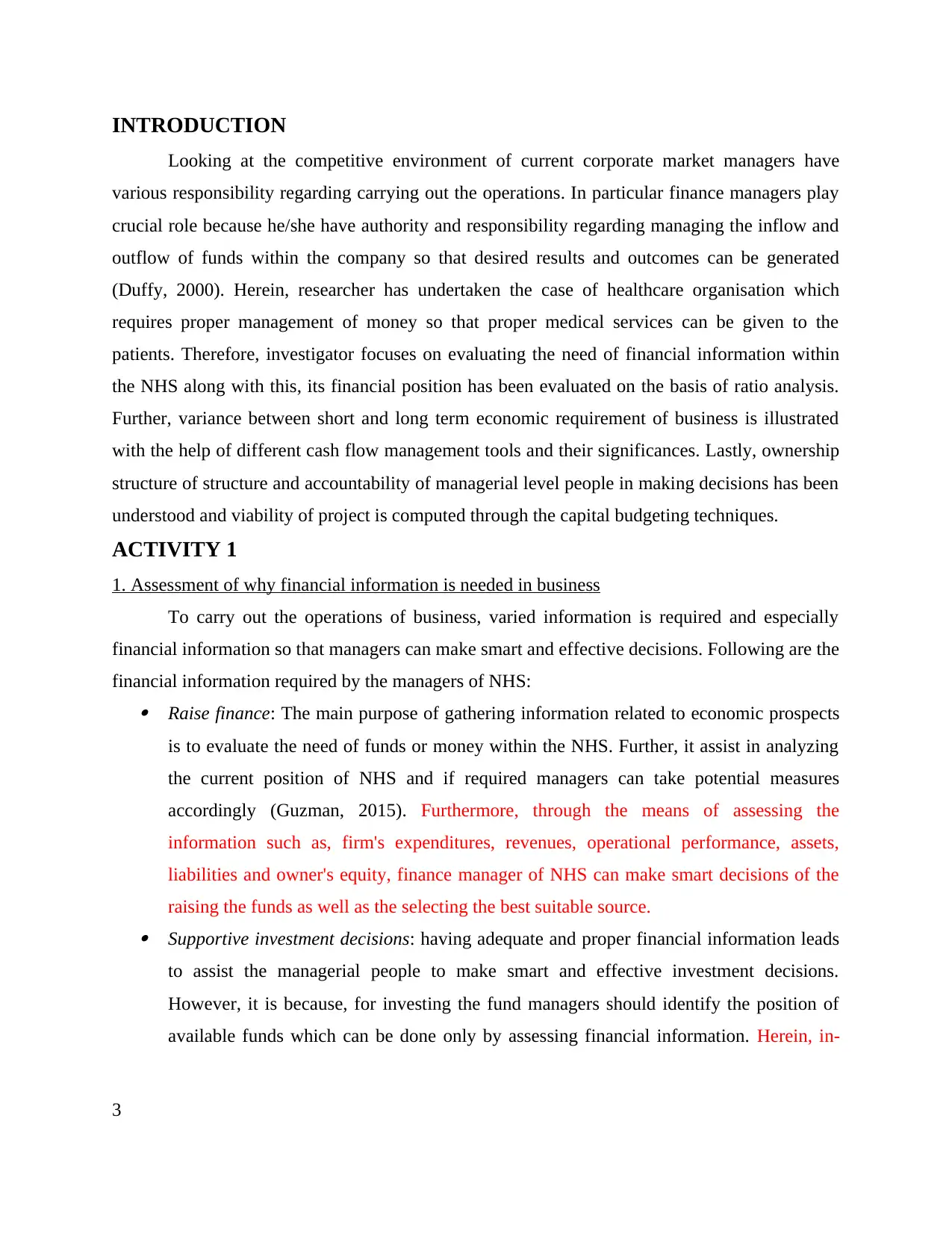
INTRODUCTION
Looking at the competitive environment of current corporate market managers have
various responsibility regarding carrying out the operations. In particular finance managers play
crucial role because he/she have authority and responsibility regarding managing the inflow and
outflow of funds within the company so that desired results and outcomes can be generated
(Duffy, 2000). Herein, researcher has undertaken the case of healthcare organisation which
requires proper management of money so that proper medical services can be given to the
patients. Therefore, investigator focuses on evaluating the need of financial information within
the NHS along with this, its financial position has been evaluated on the basis of ratio analysis.
Further, variance between short and long term economic requirement of business is illustrated
with the help of different cash flow management tools and their significances. Lastly, ownership
structure of structure and accountability of managerial level people in making decisions has been
understood and viability of project is computed through the capital budgeting techniques.
ACTIVITY 1
1. Assessment of why financial information is needed in business
To carry out the operations of business, varied information is required and especially
financial information so that managers can make smart and effective decisions. Following are the
financial information required by the managers of NHS: Raise finance: The main purpose of gathering information related to economic prospects
is to evaluate the need of funds or money within the NHS. Further, it assist in analyzing
the current position of NHS and if required managers can take potential measures
accordingly (Guzman, 2015). Furthermore, through the means of assessing the
information such as, firm's expenditures, revenues, operational performance, assets,
liabilities and owner's equity, finance manager of NHS can make smart decisions of the
raising the funds as well as the selecting the best suitable source. Supportive investment decisions: having adequate and proper financial information leads
to assist the managerial people to make smart and effective investment decisions.
However, it is because, for investing the fund managers should identify the position of
available funds which can be done only by assessing financial information. Herein, in-
3
Looking at the competitive environment of current corporate market managers have
various responsibility regarding carrying out the operations. In particular finance managers play
crucial role because he/she have authority and responsibility regarding managing the inflow and
outflow of funds within the company so that desired results and outcomes can be generated
(Duffy, 2000). Herein, researcher has undertaken the case of healthcare organisation which
requires proper management of money so that proper medical services can be given to the
patients. Therefore, investigator focuses on evaluating the need of financial information within
the NHS along with this, its financial position has been evaluated on the basis of ratio analysis.
Further, variance between short and long term economic requirement of business is illustrated
with the help of different cash flow management tools and their significances. Lastly, ownership
structure of structure and accountability of managerial level people in making decisions has been
understood and viability of project is computed through the capital budgeting techniques.
ACTIVITY 1
1. Assessment of why financial information is needed in business
To carry out the operations of business, varied information is required and especially
financial information so that managers can make smart and effective decisions. Following are the
financial information required by the managers of NHS: Raise finance: The main purpose of gathering information related to economic prospects
is to evaluate the need of funds or money within the NHS. Further, it assist in analyzing
the current position of NHS and if required managers can take potential measures
accordingly (Guzman, 2015). Furthermore, through the means of assessing the
information such as, firm's expenditures, revenues, operational performance, assets,
liabilities and owner's equity, finance manager of NHS can make smart decisions of the
raising the funds as well as the selecting the best suitable source. Supportive investment decisions: having adequate and proper financial information leads
to assist the managerial people to make smart and effective investment decisions.
However, it is because, for investing the fund managers should identify the position of
available funds which can be done only by assessing financial information. Herein, in-
3
⊘ This is a preview!⊘
Do you want full access?
Subscribe today to unlock all pages.

Trusted by 1+ million students worldwide
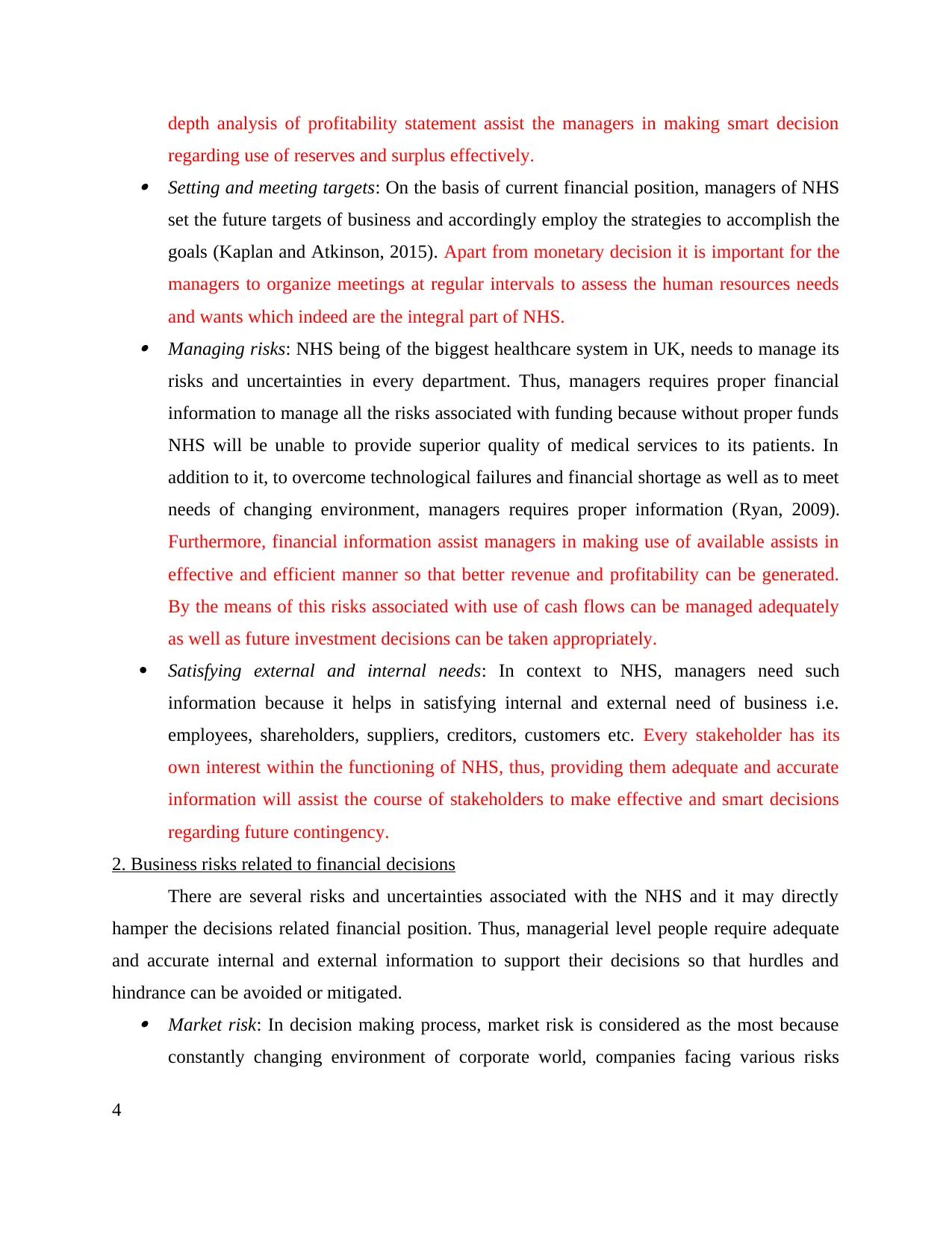
depth analysis of profitability statement assist the managers in making smart decision
regarding use of reserves and surplus effectively. Setting and meeting targets: On the basis of current financial position, managers of NHS
set the future targets of business and accordingly employ the strategies to accomplish the
goals (Kaplan and Atkinson, 2015). Apart from monetary decision it is important for the
managers to organize meetings at regular intervals to assess the human resources needs
and wants which indeed are the integral part of NHS. Managing risks: NHS being of the biggest healthcare system in UK, needs to manage its
risks and uncertainties in every department. Thus, managers requires proper financial
information to manage all the risks associated with funding because without proper funds
NHS will be unable to provide superior quality of medical services to its patients. In
addition to it, to overcome technological failures and financial shortage as well as to meet
needs of changing environment, managers requires proper information (Ryan, 2009).
Furthermore, financial information assist managers in making use of available assists in
effective and efficient manner so that better revenue and profitability can be generated.
By the means of this risks associated with use of cash flows can be managed adequately
as well as future investment decisions can be taken appropriately.
Satisfying external and internal needs: In context to NHS, managers need such
information because it helps in satisfying internal and external need of business i.e.
employees, shareholders, suppliers, creditors, customers etc. Every stakeholder has its
own interest within the functioning of NHS, thus, providing them adequate and accurate
information will assist the course of stakeholders to make effective and smart decisions
regarding future contingency.
2. Business risks related to financial decisions
There are several risks and uncertainties associated with the NHS and it may directly
hamper the decisions related financial position. Thus, managerial level people require adequate
and accurate internal and external information to support their decisions so that hurdles and
hindrance can be avoided or mitigated. Market risk: In decision making process, market risk is considered as the most because
constantly changing environment of corporate world, companies facing various risks
4
regarding use of reserves and surplus effectively. Setting and meeting targets: On the basis of current financial position, managers of NHS
set the future targets of business and accordingly employ the strategies to accomplish the
goals (Kaplan and Atkinson, 2015). Apart from monetary decision it is important for the
managers to organize meetings at regular intervals to assess the human resources needs
and wants which indeed are the integral part of NHS. Managing risks: NHS being of the biggest healthcare system in UK, needs to manage its
risks and uncertainties in every department. Thus, managers requires proper financial
information to manage all the risks associated with funding because without proper funds
NHS will be unable to provide superior quality of medical services to its patients. In
addition to it, to overcome technological failures and financial shortage as well as to meet
needs of changing environment, managers requires proper information (Ryan, 2009).
Furthermore, financial information assist managers in making use of available assists in
effective and efficient manner so that better revenue and profitability can be generated.
By the means of this risks associated with use of cash flows can be managed adequately
as well as future investment decisions can be taken appropriately.
Satisfying external and internal needs: In context to NHS, managers need such
information because it helps in satisfying internal and external need of business i.e.
employees, shareholders, suppliers, creditors, customers etc. Every stakeholder has its
own interest within the functioning of NHS, thus, providing them adequate and accurate
information will assist the course of stakeholders to make effective and smart decisions
regarding future contingency.
2. Business risks related to financial decisions
There are several risks and uncertainties associated with the NHS and it may directly
hamper the decisions related financial position. Thus, managerial level people require adequate
and accurate internal and external information to support their decisions so that hurdles and
hindrance can be avoided or mitigated. Market risk: In decision making process, market risk is considered as the most because
constantly changing environment of corporate world, companies facing various risks
4
Paraphrase This Document
Need a fresh take? Get an instant paraphrase of this document with our AI Paraphraser
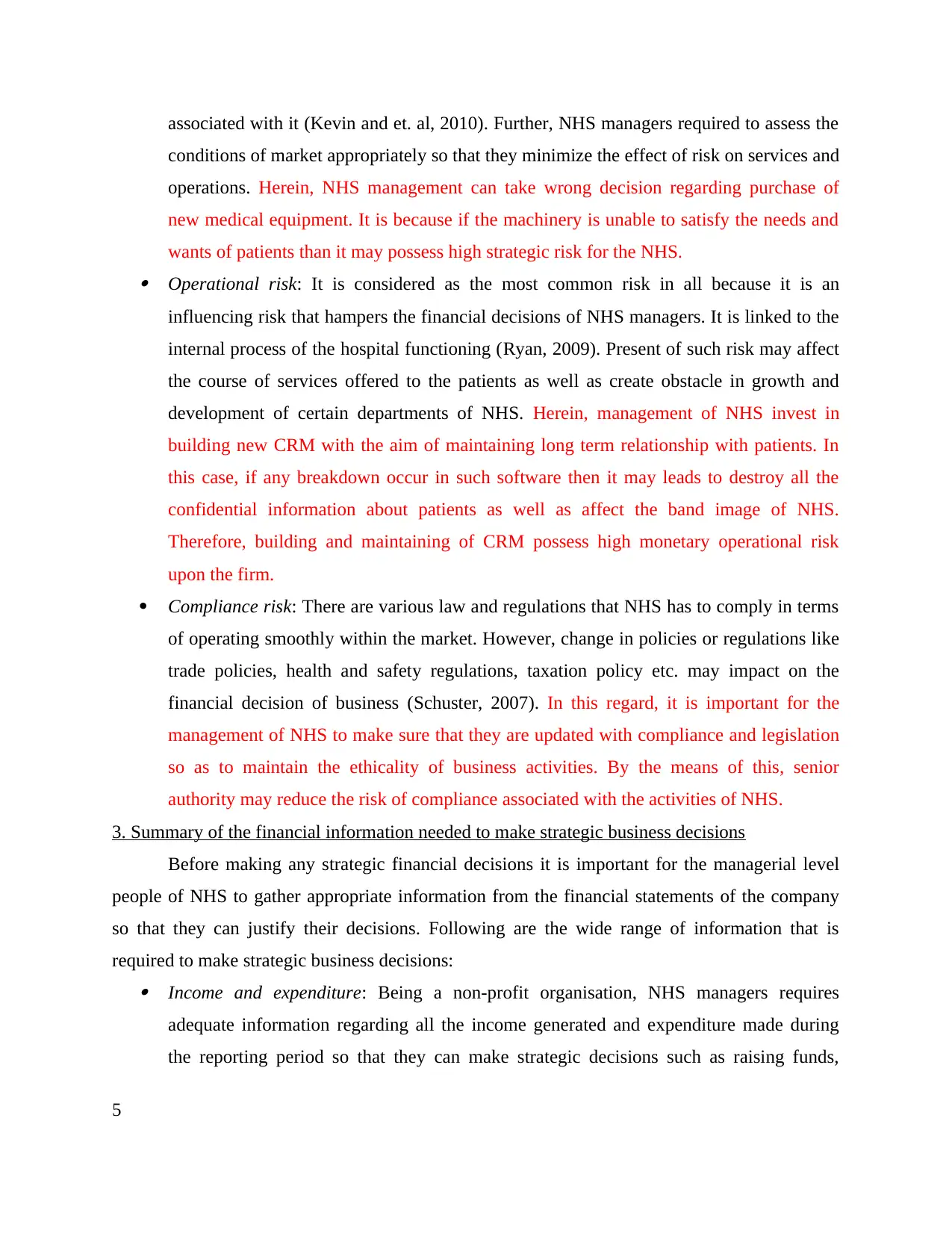
associated with it (Kevin and et. al, 2010). Further, NHS managers required to assess the
conditions of market appropriately so that they minimize the effect of risk on services and
operations. Herein, NHS management can take wrong decision regarding purchase of
new medical equipment. It is because if the machinery is unable to satisfy the needs and
wants of patients than it may possess high strategic risk for the NHS. Operational risk: It is considered as the most common risk in all because it is an
influencing risk that hampers the financial decisions of NHS managers. It is linked to the
internal process of the hospital functioning (Ryan, 2009). Present of such risk may affect
the course of services offered to the patients as well as create obstacle in growth and
development of certain departments of NHS. Herein, management of NHS invest in
building new CRM with the aim of maintaining long term relationship with patients. In
this case, if any breakdown occur in such software then it may leads to destroy all the
confidential information about patients as well as affect the band image of NHS.
Therefore, building and maintaining of CRM possess high monetary operational risk
upon the firm.
Compliance risk: There are various law and regulations that NHS has to comply in terms
of operating smoothly within the market. However, change in policies or regulations like
trade policies, health and safety regulations, taxation policy etc. may impact on the
financial decision of business (Schuster, 2007). In this regard, it is important for the
management of NHS to make sure that they are updated with compliance and legislation
so as to maintain the ethicality of business activities. By the means of this, senior
authority may reduce the risk of compliance associated with the activities of NHS.
3. Summary of the financial information needed to make strategic business decisions
Before making any strategic financial decisions it is important for the managerial level
people of NHS to gather appropriate information from the financial statements of the company
so that they can justify their decisions. Following are the wide range of information that is
required to make strategic business decisions: Income and expenditure: Being a non-profit organisation, NHS managers requires
adequate information regarding all the income generated and expenditure made during
the reporting period so that they can make strategic decisions such as raising funds,
5
conditions of market appropriately so that they minimize the effect of risk on services and
operations. Herein, NHS management can take wrong decision regarding purchase of
new medical equipment. It is because if the machinery is unable to satisfy the needs and
wants of patients than it may possess high strategic risk for the NHS. Operational risk: It is considered as the most common risk in all because it is an
influencing risk that hampers the financial decisions of NHS managers. It is linked to the
internal process of the hospital functioning (Ryan, 2009). Present of such risk may affect
the course of services offered to the patients as well as create obstacle in growth and
development of certain departments of NHS. Herein, management of NHS invest in
building new CRM with the aim of maintaining long term relationship with patients. In
this case, if any breakdown occur in such software then it may leads to destroy all the
confidential information about patients as well as affect the band image of NHS.
Therefore, building and maintaining of CRM possess high monetary operational risk
upon the firm.
Compliance risk: There are various law and regulations that NHS has to comply in terms
of operating smoothly within the market. However, change in policies or regulations like
trade policies, health and safety regulations, taxation policy etc. may impact on the
financial decision of business (Schuster, 2007). In this regard, it is important for the
management of NHS to make sure that they are updated with compliance and legislation
so as to maintain the ethicality of business activities. By the means of this, senior
authority may reduce the risk of compliance associated with the activities of NHS.
3. Summary of the financial information needed to make strategic business decisions
Before making any strategic financial decisions it is important for the managerial level
people of NHS to gather appropriate information from the financial statements of the company
so that they can justify their decisions. Following are the wide range of information that is
required to make strategic business decisions: Income and expenditure: Being a non-profit organisation, NHS managers requires
adequate information regarding all the income generated and expenditure made during
the reporting period so that they can make strategic decisions such as raising funds,
5
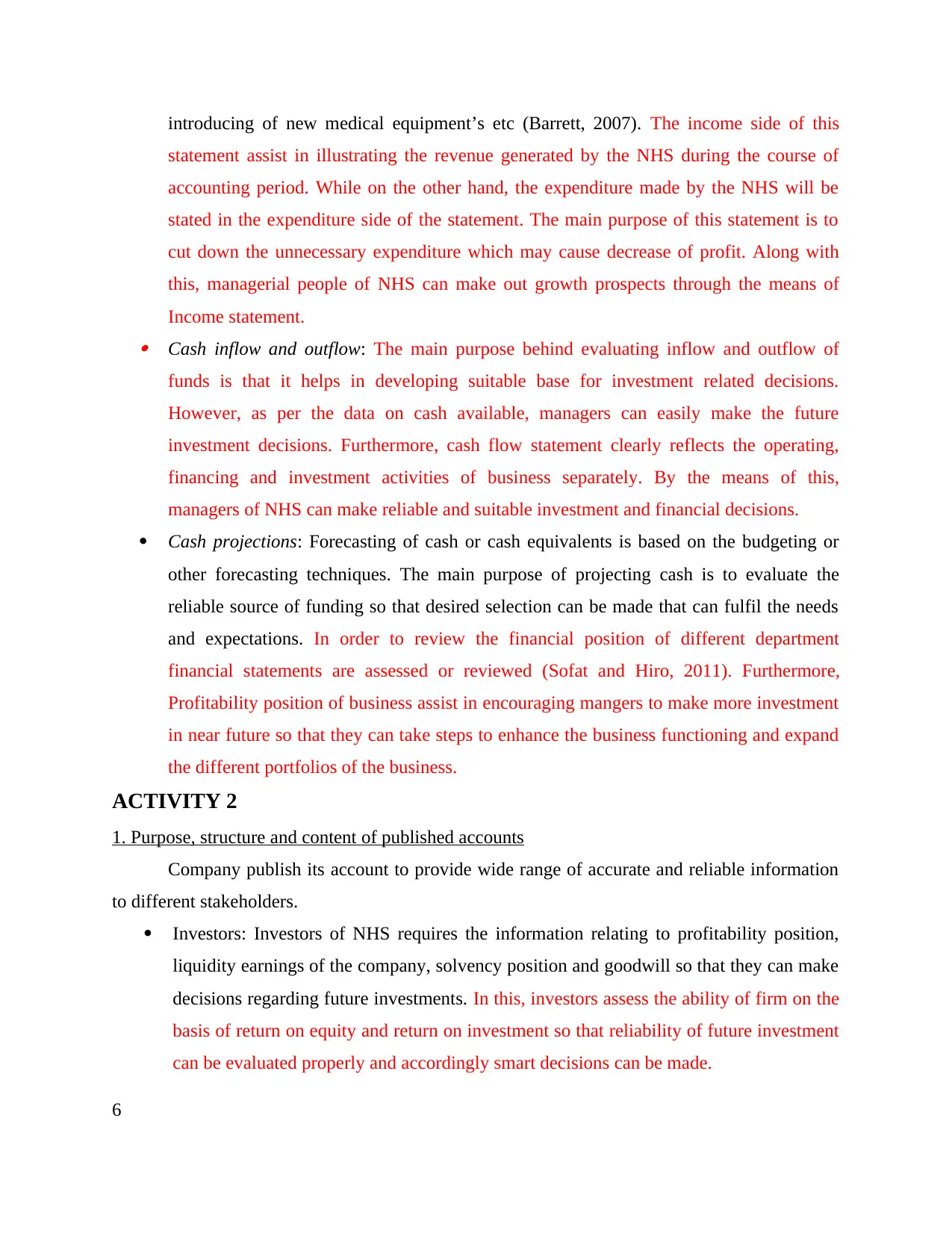
introducing of new medical equipment’s etc (Barrett, 2007). The income side of this
statement assist in illustrating the revenue generated by the NHS during the course of
accounting period. While on the other hand, the expenditure made by the NHS will be
stated in the expenditure side of the statement. The main purpose of this statement is to
cut down the unnecessary expenditure which may cause decrease of profit. Along with
this, managerial people of NHS can make out growth prospects through the means of
Income statement. Cash inflow and outflow: The main purpose behind evaluating inflow and outflow of
funds is that it helps in developing suitable base for investment related decisions.
However, as per the data on cash available, managers can easily make the future
investment decisions. Furthermore, cash flow statement clearly reflects the operating,
financing and investment activities of business separately. By the means of this,
managers of NHS can make reliable and suitable investment and financial decisions.
Cash projections: Forecasting of cash or cash equivalents is based on the budgeting or
other forecasting techniques. The main purpose of projecting cash is to evaluate the
reliable source of funding so that desired selection can be made that can fulfil the needs
and expectations. In order to review the financial position of different department
financial statements are assessed or reviewed (Sofat and Hiro, 2011). Furthermore,
Profitability position of business assist in encouraging mangers to make more investment
in near future so that they can take steps to enhance the business functioning and expand
the different portfolios of the business.
ACTIVITY 2
1. Purpose, structure and content of published accounts
Company publish its account to provide wide range of accurate and reliable information
to different stakeholders.
Investors: Investors of NHS requires the information relating to profitability position,
liquidity earnings of the company, solvency position and goodwill so that they can make
decisions regarding future investments. In this, investors assess the ability of firm on the
basis of return on equity and return on investment so that reliability of future investment
can be evaluated properly and accordingly smart decisions can be made.
6
statement assist in illustrating the revenue generated by the NHS during the course of
accounting period. While on the other hand, the expenditure made by the NHS will be
stated in the expenditure side of the statement. The main purpose of this statement is to
cut down the unnecessary expenditure which may cause decrease of profit. Along with
this, managerial people of NHS can make out growth prospects through the means of
Income statement. Cash inflow and outflow: The main purpose behind evaluating inflow and outflow of
funds is that it helps in developing suitable base for investment related decisions.
However, as per the data on cash available, managers can easily make the future
investment decisions. Furthermore, cash flow statement clearly reflects the operating,
financing and investment activities of business separately. By the means of this,
managers of NHS can make reliable and suitable investment and financial decisions.
Cash projections: Forecasting of cash or cash equivalents is based on the budgeting or
other forecasting techniques. The main purpose of projecting cash is to evaluate the
reliable source of funding so that desired selection can be made that can fulfil the needs
and expectations. In order to review the financial position of different department
financial statements are assessed or reviewed (Sofat and Hiro, 2011). Furthermore,
Profitability position of business assist in encouraging mangers to make more investment
in near future so that they can take steps to enhance the business functioning and expand
the different portfolios of the business.
ACTIVITY 2
1. Purpose, structure and content of published accounts
Company publish its account to provide wide range of accurate and reliable information
to different stakeholders.
Investors: Investors of NHS requires the information relating to profitability position,
liquidity earnings of the company, solvency position and goodwill so that they can make
decisions regarding future investments. In this, investors assess the ability of firm on the
basis of return on equity and return on investment so that reliability of future investment
can be evaluated properly and accordingly smart decisions can be made.
6
⊘ This is a preview!⊘
Do you want full access?
Subscribe today to unlock all pages.

Trusted by 1+ million students worldwide
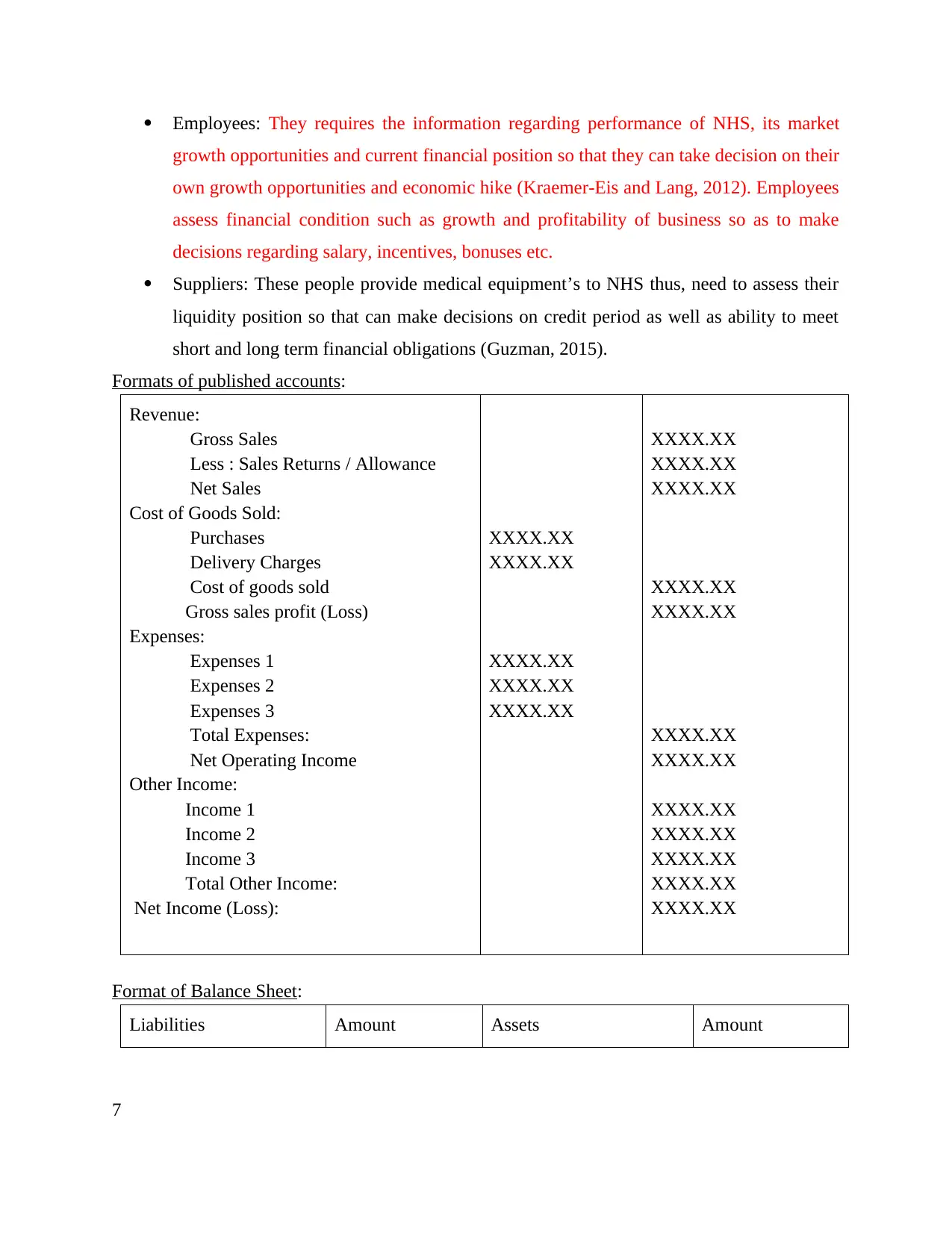
Employees: They requires the information regarding performance of NHS, its market
growth opportunities and current financial position so that they can take decision on their
own growth opportunities and economic hike (Kraemer-Eis and Lang, 2012). Employees
assess financial condition such as growth and profitability of business so as to make
decisions regarding salary, incentives, bonuses etc.
Suppliers: These people provide medical equipment’s to NHS thus, need to assess their
liquidity position so that can make decisions on credit period as well as ability to meet
short and long term financial obligations (Guzman, 2015).
Formats of published accounts:
Revenue:
Gross Sales
Less : Sales Returns / Allowance
Net Sales
Cost of Goods Sold:
Purchases
Delivery Charges
Cost of goods sold
Gross sales profit (Loss)
Expenses:
Expenses 1
Expenses 2
Expenses 3
Total Expenses:
Net Operating Income
Other Income:
Income 1
Income 2
Income 3
Total Other Income:
Net Income (Loss):
XXXX.XX
XXXX.XX
XXXX.XX
XXXX.XX
XXXX.XX
XXXX.XX
XXXX.XX
XXXX.XX
XXXX.XX
XXXX.XX
XXXX.XX
XXXX.XX
XXXX.XX
XXXX.XX
XXXX.XX
XXXX.XX
XXXX.XX
Format of Balance Sheet:
Liabilities Amount Assets Amount
7
growth opportunities and current financial position so that they can take decision on their
own growth opportunities and economic hike (Kraemer-Eis and Lang, 2012). Employees
assess financial condition such as growth and profitability of business so as to make
decisions regarding salary, incentives, bonuses etc.
Suppliers: These people provide medical equipment’s to NHS thus, need to assess their
liquidity position so that can make decisions on credit period as well as ability to meet
short and long term financial obligations (Guzman, 2015).
Formats of published accounts:
Revenue:
Gross Sales
Less : Sales Returns / Allowance
Net Sales
Cost of Goods Sold:
Purchases
Delivery Charges
Cost of goods sold
Gross sales profit (Loss)
Expenses:
Expenses 1
Expenses 2
Expenses 3
Total Expenses:
Net Operating Income
Other Income:
Income 1
Income 2
Income 3
Total Other Income:
Net Income (Loss):
XXXX.XX
XXXX.XX
XXXX.XX
XXXX.XX
XXXX.XX
XXXX.XX
XXXX.XX
XXXX.XX
XXXX.XX
XXXX.XX
XXXX.XX
XXXX.XX
XXXX.XX
XXXX.XX
XXXX.XX
XXXX.XX
XXXX.XX
Format of Balance Sheet:
Liabilities Amount Assets Amount
7
Paraphrase This Document
Need a fresh take? Get an instant paraphrase of this document with our AI Paraphraser
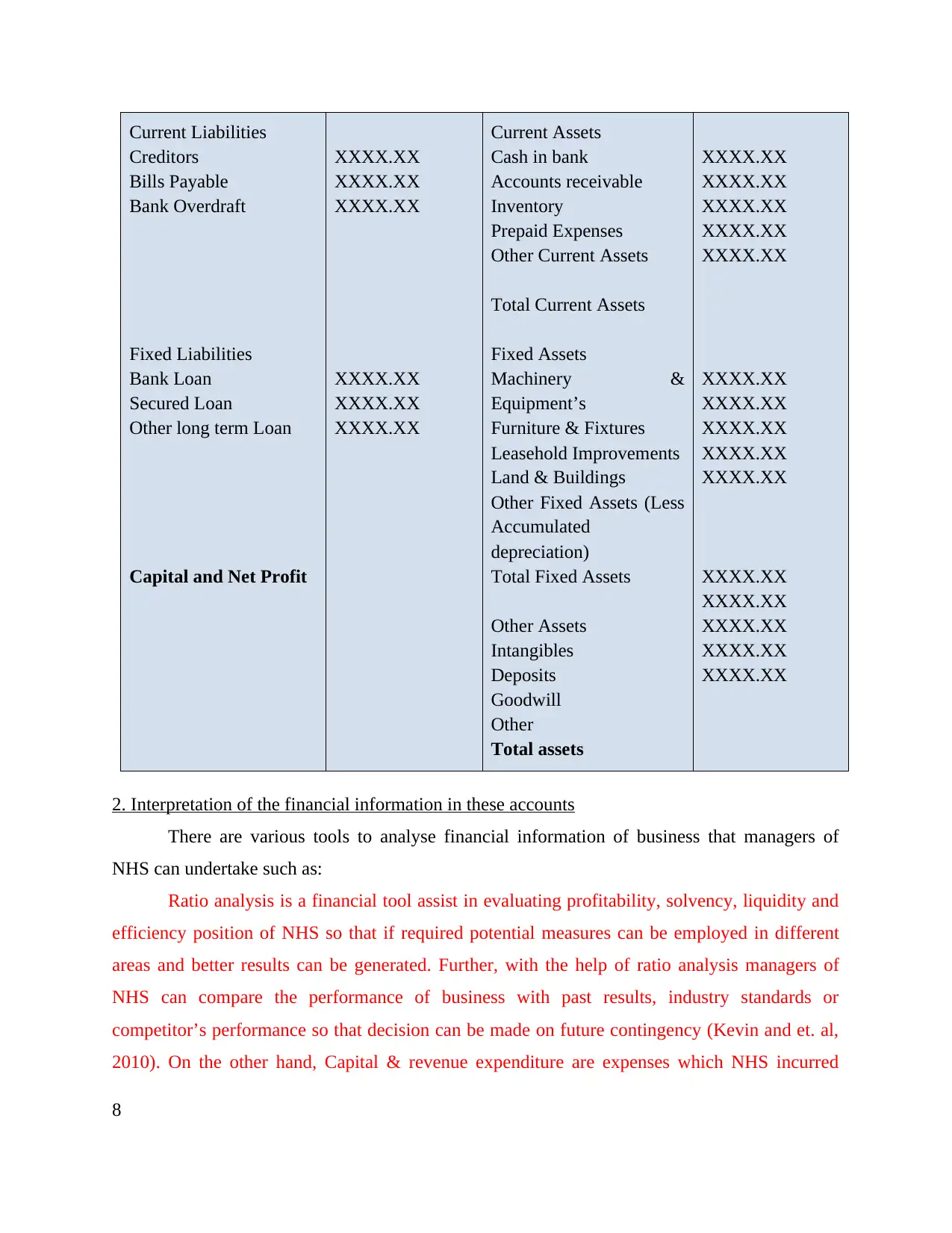
Current Liabilities
Creditors
Bills Payable
Bank Overdraft
Fixed Liabilities
Bank Loan
Secured Loan
Other long term Loan
Capital and Net Profit
XXXX.XX
XXXX.XX
XXXX.XX
XXXX.XX
XXXX.XX
XXXX.XX
Current Assets
Cash in bank
Accounts receivable
Inventory
Prepaid Expenses
Other Current Assets
Total Current Assets
Fixed Assets
Machinery &
Equipment’s
Furniture & Fixtures
Leasehold Improvements
Land & Buildings
Other Fixed Assets (Less
Accumulated
depreciation)
Total Fixed Assets
Other Assets
Intangibles
Deposits
Goodwill
Other
Total assets
XXXX.XX
XXXX.XX
XXXX.XX
XXXX.XX
XXXX.XX
XXXX.XX
XXXX.XX
XXXX.XX
XXXX.XX
XXXX.XX
XXXX.XX
XXXX.XX
XXXX.XX
XXXX.XX
XXXX.XX
2. Interpretation of the financial information in these accounts
There are various tools to analyse financial information of business that managers of
NHS can undertake such as:
Ratio analysis is a financial tool assist in evaluating profitability, solvency, liquidity and
efficiency position of NHS so that if required potential measures can be employed in different
areas and better results can be generated. Further, with the help of ratio analysis managers of
NHS can compare the performance of business with past results, industry standards or
competitor’s performance so that decision can be made on future contingency (Kevin and et. al,
2010). On the other hand, Capital & revenue expenditure are expenses which NHS incurred
8
Creditors
Bills Payable
Bank Overdraft
Fixed Liabilities
Bank Loan
Secured Loan
Other long term Loan
Capital and Net Profit
XXXX.XX
XXXX.XX
XXXX.XX
XXXX.XX
XXXX.XX
XXXX.XX
Current Assets
Cash in bank
Accounts receivable
Inventory
Prepaid Expenses
Other Current Assets
Total Current Assets
Fixed Assets
Machinery &
Equipment’s
Furniture & Fixtures
Leasehold Improvements
Land & Buildings
Other Fixed Assets (Less
Accumulated
depreciation)
Total Fixed Assets
Other Assets
Intangibles
Deposits
Goodwill
Other
Total assets
XXXX.XX
XXXX.XX
XXXX.XX
XXXX.XX
XXXX.XX
XXXX.XX
XXXX.XX
XXXX.XX
XXXX.XX
XXXX.XX
XXXX.XX
XXXX.XX
XXXX.XX
XXXX.XX
XXXX.XX
2. Interpretation of the financial information in these accounts
There are various tools to analyse financial information of business that managers of
NHS can undertake such as:
Ratio analysis is a financial tool assist in evaluating profitability, solvency, liquidity and
efficiency position of NHS so that if required potential measures can be employed in different
areas and better results can be generated. Further, with the help of ratio analysis managers of
NHS can compare the performance of business with past results, industry standards or
competitor’s performance so that decision can be made on future contingency (Kevin and et. al,
2010). On the other hand, Capital & revenue expenditure are expenses which NHS incurred
8
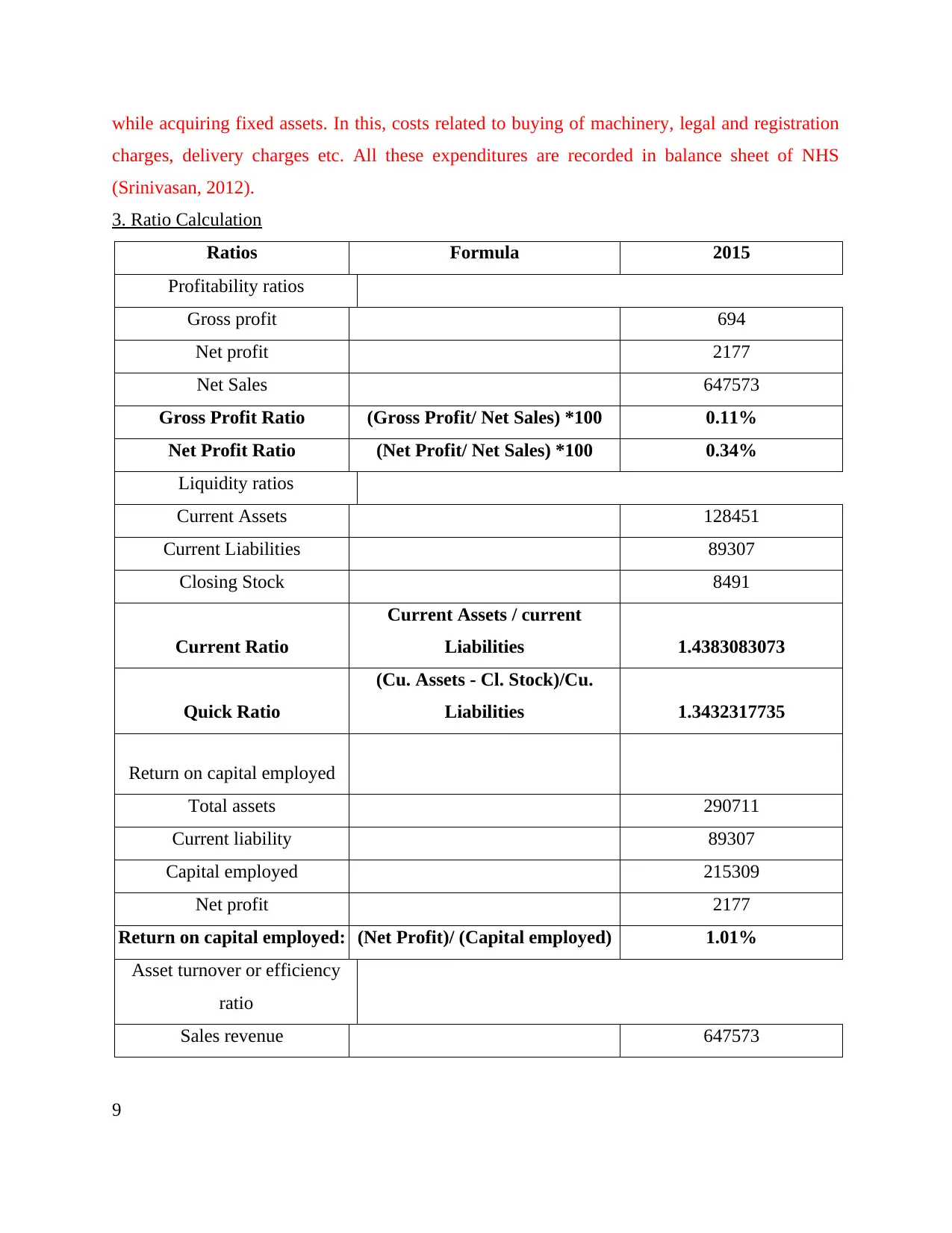
while acquiring fixed assets. In this, costs related to buying of machinery, legal and registration
charges, delivery charges etc. All these expenditures are recorded in balance sheet of NHS
(Srinivasan, 2012).
3. Ratio Calculation
Ratios Formula 2015
Profitability ratios
Gross profit 694
Net profit 2177
Net Sales 647573
Gross Profit Ratio (Gross Profit/ Net Sales) *100 0.11%
Net Profit Ratio (Net Profit/ Net Sales) *100 0.34%
Liquidity ratios
Current Assets 128451
Current Liabilities 89307
Closing Stock 8491
Current Ratio
Current Assets / current
Liabilities 1.4383083073
Quick Ratio
(Cu. Assets - Cl. Stock)/Cu.
Liabilities 1.3432317735
Return on capital employed
Total assets 290711
Current liability 89307
Capital employed 215309
Net profit 2177
Return on capital employed: (Net Profit)/ (Capital employed) 1.01%
Asset turnover or efficiency
ratio
Sales revenue 647573
9
charges, delivery charges etc. All these expenditures are recorded in balance sheet of NHS
(Srinivasan, 2012).
3. Ratio Calculation
Ratios Formula 2015
Profitability ratios
Gross profit 694
Net profit 2177
Net Sales 647573
Gross Profit Ratio (Gross Profit/ Net Sales) *100 0.11%
Net Profit Ratio (Net Profit/ Net Sales) *100 0.34%
Liquidity ratios
Current Assets 128451
Current Liabilities 89307
Closing Stock 8491
Current Ratio
Current Assets / current
Liabilities 1.4383083073
Quick Ratio
(Cu. Assets - Cl. Stock)/Cu.
Liabilities 1.3432317735
Return on capital employed
Total assets 290711
Current liability 89307
Capital employed 215309
Net profit 2177
Return on capital employed: (Net Profit)/ (Capital employed) 1.01%
Asset turnover or efficiency
ratio
Sales revenue 647573
9
⊘ This is a preview!⊘
Do you want full access?
Subscribe today to unlock all pages.

Trusted by 1+ million students worldwide
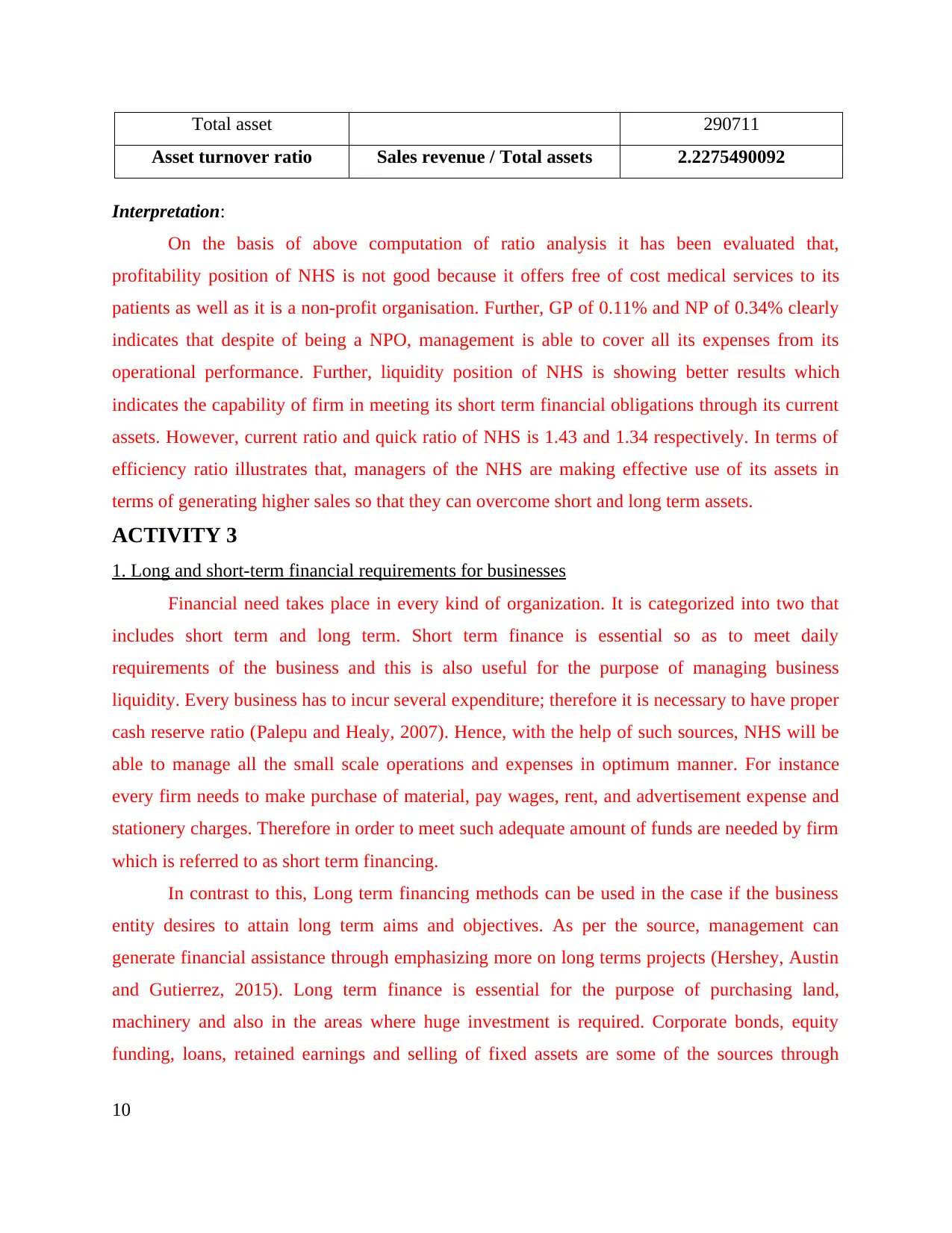
Total asset 290711
Asset turnover ratio Sales revenue / Total assets 2.2275490092
Interpretation:
On the basis of above computation of ratio analysis it has been evaluated that,
profitability position of NHS is not good because it offers free of cost medical services to its
patients as well as it is a non-profit organisation. Further, GP of 0.11% and NP of 0.34% clearly
indicates that despite of being a NPO, management is able to cover all its expenses from its
operational performance. Further, liquidity position of NHS is showing better results which
indicates the capability of firm in meeting its short term financial obligations through its current
assets. However, current ratio and quick ratio of NHS is 1.43 and 1.34 respectively. In terms of
efficiency ratio illustrates that, managers of the NHS are making effective use of its assets in
terms of generating higher sales so that they can overcome short and long term assets.
ACTIVITY 3
1. Long and short-term financial requirements for businesses
Financial need takes place in every kind of organization. It is categorized into two that
includes short term and long term. Short term finance is essential so as to meet daily
requirements of the business and this is also useful for the purpose of managing business
liquidity. Every business has to incur several expenditure; therefore it is necessary to have proper
cash reserve ratio (Palepu and Healy, 2007). Hence, with the help of such sources, NHS will be
able to manage all the small scale operations and expenses in optimum manner. For instance
every firm needs to make purchase of material, pay wages, rent, and advertisement expense and
stationery charges. Therefore in order to meet such adequate amount of funds are needed by firm
which is referred to as short term financing.
In contrast to this, Long term financing methods can be used in the case if the business
entity desires to attain long term aims and objectives. As per the source, management can
generate financial assistance through emphasizing more on long terms projects (Hershey, Austin
and Gutierrez, 2015). Long term finance is essential for the purpose of purchasing land,
machinery and also in the areas where huge investment is required. Corporate bonds, equity
funding, loans, retained earnings and selling of fixed assets are some of the sources through
10
Asset turnover ratio Sales revenue / Total assets 2.2275490092
Interpretation:
On the basis of above computation of ratio analysis it has been evaluated that,
profitability position of NHS is not good because it offers free of cost medical services to its
patients as well as it is a non-profit organisation. Further, GP of 0.11% and NP of 0.34% clearly
indicates that despite of being a NPO, management is able to cover all its expenses from its
operational performance. Further, liquidity position of NHS is showing better results which
indicates the capability of firm in meeting its short term financial obligations through its current
assets. However, current ratio and quick ratio of NHS is 1.43 and 1.34 respectively. In terms of
efficiency ratio illustrates that, managers of the NHS are making effective use of its assets in
terms of generating higher sales so that they can overcome short and long term assets.
ACTIVITY 3
1. Long and short-term financial requirements for businesses
Financial need takes place in every kind of organization. It is categorized into two that
includes short term and long term. Short term finance is essential so as to meet daily
requirements of the business and this is also useful for the purpose of managing business
liquidity. Every business has to incur several expenditure; therefore it is necessary to have proper
cash reserve ratio (Palepu and Healy, 2007). Hence, with the help of such sources, NHS will be
able to manage all the small scale operations and expenses in optimum manner. For instance
every firm needs to make purchase of material, pay wages, rent, and advertisement expense and
stationery charges. Therefore in order to meet such adequate amount of funds are needed by firm
which is referred to as short term financing.
In contrast to this, Long term financing methods can be used in the case if the business
entity desires to attain long term aims and objectives. As per the source, management can
generate financial assistance through emphasizing more on long terms projects (Hershey, Austin
and Gutierrez, 2015). Long term finance is essential for the purpose of purchasing land,
machinery and also in the areas where huge investment is required. Corporate bonds, equity
funding, loans, retained earnings and selling of fixed assets are some of the sources through
10
Paraphrase This Document
Need a fresh take? Get an instant paraphrase of this document with our AI Paraphraser
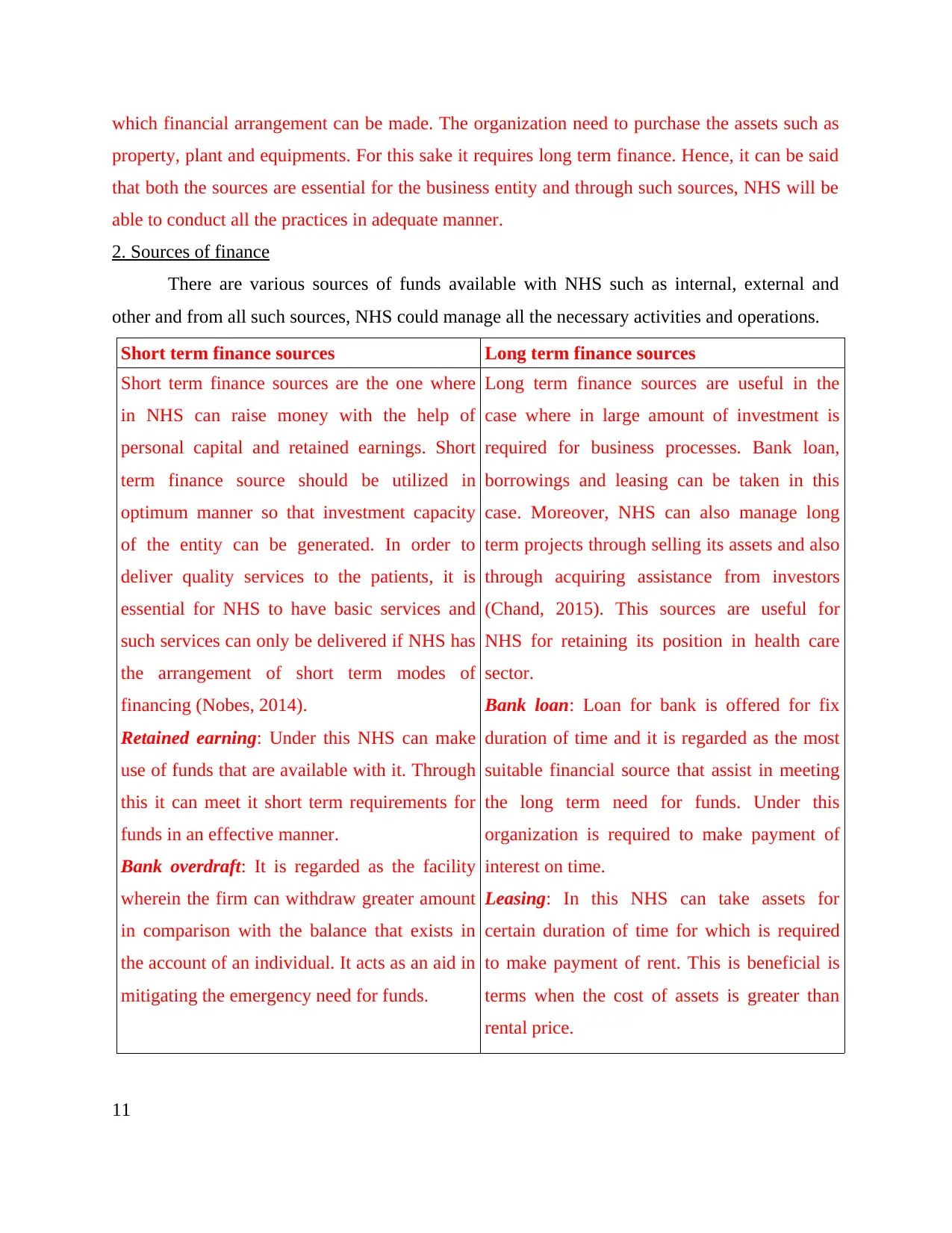
which financial arrangement can be made. The organization need to purchase the assets such as
property, plant and equipments. For this sake it requires long term finance. Hence, it can be said
that both the sources are essential for the business entity and through such sources, NHS will be
able to conduct all the practices in adequate manner.
2. Sources of finance
There are various sources of funds available with NHS such as internal, external and
other and from all such sources, NHS could manage all the necessary activities and operations.
Short term finance sources Long term finance sources
Short term finance sources are the one where
in NHS can raise money with the help of
personal capital and retained earnings. Short
term finance source should be utilized in
optimum manner so that investment capacity
of the entity can be generated. In order to
deliver quality services to the patients, it is
essential for NHS to have basic services and
such services can only be delivered if NHS has
the arrangement of short term modes of
financing (Nobes, 2014).
Retained earning: Under this NHS can make
use of funds that are available with it. Through
this it can meet it short term requirements for
funds in an effective manner.
Bank overdraft: It is regarded as the facility
wherein the firm can withdraw greater amount
in comparison with the balance that exists in
the account of an individual. It acts as an aid in
mitigating the emergency need for funds.
Long term finance sources are useful in the
case where in large amount of investment is
required for business processes. Bank loan,
borrowings and leasing can be taken in this
case. Moreover, NHS can also manage long
term projects through selling its assets and also
through acquiring assistance from investors
(Chand, 2015). This sources are useful for
NHS for retaining its position in health care
sector.
Bank loan: Loan for bank is offered for fix
duration of time and it is regarded as the most
suitable financial source that assist in meeting
the long term need for funds. Under this
organization is required to make payment of
interest on time.
Leasing: In this NHS can take assets for
certain duration of time for which is required
to make payment of rent. This is beneficial is
terms when the cost of assets is greater than
rental price.
11
property, plant and equipments. For this sake it requires long term finance. Hence, it can be said
that both the sources are essential for the business entity and through such sources, NHS will be
able to conduct all the practices in adequate manner.
2. Sources of finance
There are various sources of funds available with NHS such as internal, external and
other and from all such sources, NHS could manage all the necessary activities and operations.
Short term finance sources Long term finance sources
Short term finance sources are the one where
in NHS can raise money with the help of
personal capital and retained earnings. Short
term finance source should be utilized in
optimum manner so that investment capacity
of the entity can be generated. In order to
deliver quality services to the patients, it is
essential for NHS to have basic services and
such services can only be delivered if NHS has
the arrangement of short term modes of
financing (Nobes, 2014).
Retained earning: Under this NHS can make
use of funds that are available with it. Through
this it can meet it short term requirements for
funds in an effective manner.
Bank overdraft: It is regarded as the facility
wherein the firm can withdraw greater amount
in comparison with the balance that exists in
the account of an individual. It acts as an aid in
mitigating the emergency need for funds.
Long term finance sources are useful in the
case where in large amount of investment is
required for business processes. Bank loan,
borrowings and leasing can be taken in this
case. Moreover, NHS can also manage long
term projects through selling its assets and also
through acquiring assistance from investors
(Chand, 2015). This sources are useful for
NHS for retaining its position in health care
sector.
Bank loan: Loan for bank is offered for fix
duration of time and it is regarded as the most
suitable financial source that assist in meeting
the long term need for funds. Under this
organization is required to make payment of
interest on time.
Leasing: In this NHS can take assets for
certain duration of time for which is required
to make payment of rent. This is beneficial is
terms when the cost of assets is greater than
rental price.
11
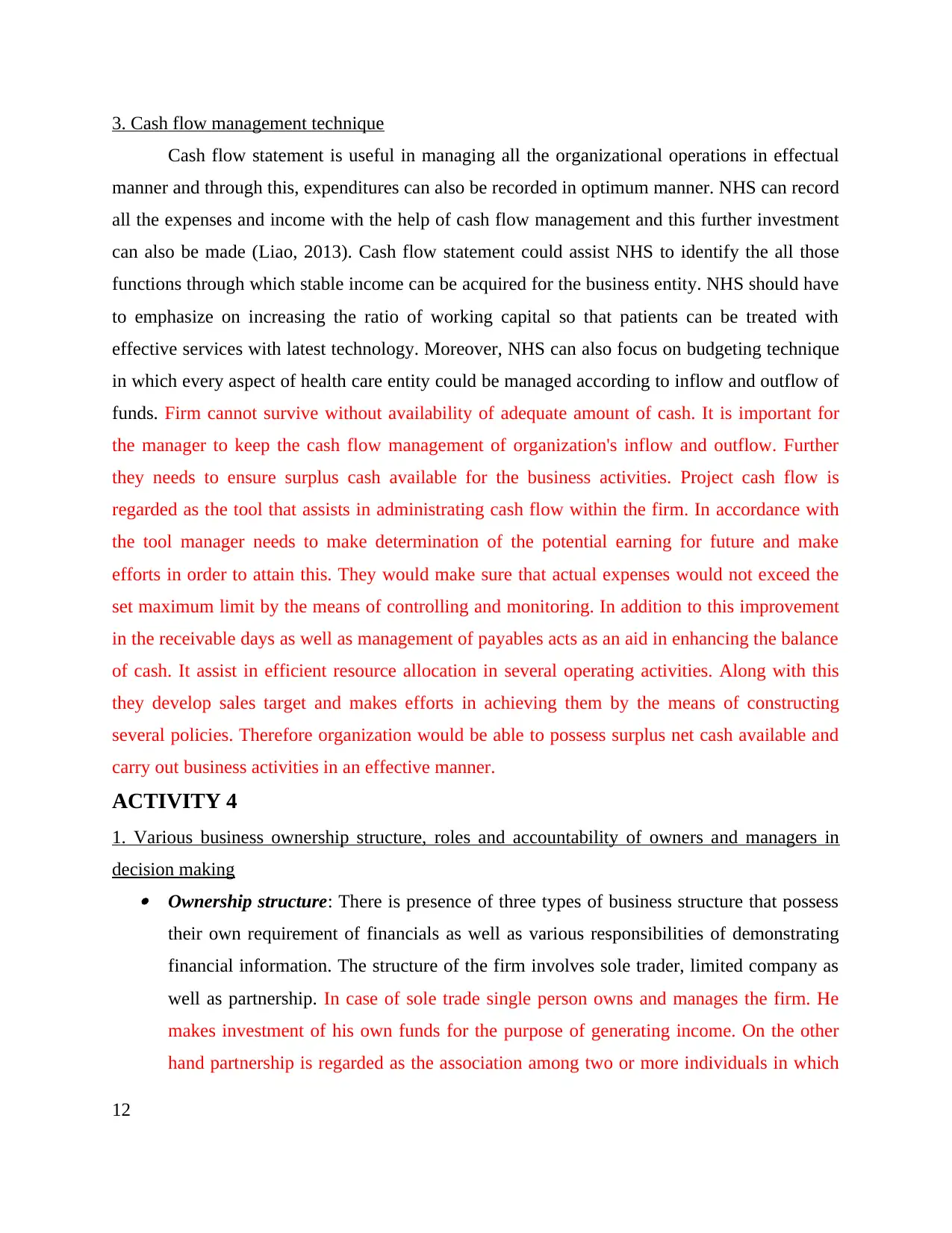
3. Cash flow management technique
Cash flow statement is useful in managing all the organizational operations in effectual
manner and through this, expenditures can also be recorded in optimum manner. NHS can record
all the expenses and income with the help of cash flow management and this further investment
can also be made (Liao, 2013). Cash flow statement could assist NHS to identify the all those
functions through which stable income can be acquired for the business entity. NHS should have
to emphasize on increasing the ratio of working capital so that patients can be treated with
effective services with latest technology. Moreover, NHS can also focus on budgeting technique
in which every aspect of health care entity could be managed according to inflow and outflow of
funds. Firm cannot survive without availability of adequate amount of cash. It is important for
the manager to keep the cash flow management of organization's inflow and outflow. Further
they needs to ensure surplus cash available for the business activities. Project cash flow is
regarded as the tool that assists in administrating cash flow within the firm. In accordance with
the tool manager needs to make determination of the potential earning for future and make
efforts in order to attain this. They would make sure that actual expenses would not exceed the
set maximum limit by the means of controlling and monitoring. In addition to this improvement
in the receivable days as well as management of payables acts as an aid in enhancing the balance
of cash. It assist in efficient resource allocation in several operating activities. Along with this
they develop sales target and makes efforts in achieving them by the means of constructing
several policies. Therefore organization would be able to possess surplus net cash available and
carry out business activities in an effective manner.
ACTIVITY 4
1. Various business ownership structure, roles and accountability of owners and managers in
decision making Ownership structure: There is presence of three types of business structure that possess
their own requirement of financials as well as various responsibilities of demonstrating
financial information. The structure of the firm involves sole trader, limited company as
well as partnership. In case of sole trade single person owns and manages the firm. He
makes investment of his own funds for the purpose of generating income. On the other
hand partnership is regarded as the association among two or more individuals in which
12
Cash flow statement is useful in managing all the organizational operations in effectual
manner and through this, expenditures can also be recorded in optimum manner. NHS can record
all the expenses and income with the help of cash flow management and this further investment
can also be made (Liao, 2013). Cash flow statement could assist NHS to identify the all those
functions through which stable income can be acquired for the business entity. NHS should have
to emphasize on increasing the ratio of working capital so that patients can be treated with
effective services with latest technology. Moreover, NHS can also focus on budgeting technique
in which every aspect of health care entity could be managed according to inflow and outflow of
funds. Firm cannot survive without availability of adequate amount of cash. It is important for
the manager to keep the cash flow management of organization's inflow and outflow. Further
they needs to ensure surplus cash available for the business activities. Project cash flow is
regarded as the tool that assists in administrating cash flow within the firm. In accordance with
the tool manager needs to make determination of the potential earning for future and make
efforts in order to attain this. They would make sure that actual expenses would not exceed the
set maximum limit by the means of controlling and monitoring. In addition to this improvement
in the receivable days as well as management of payables acts as an aid in enhancing the balance
of cash. It assist in efficient resource allocation in several operating activities. Along with this
they develop sales target and makes efforts in achieving them by the means of constructing
several policies. Therefore organization would be able to possess surplus net cash available and
carry out business activities in an effective manner.
ACTIVITY 4
1. Various business ownership structure, roles and accountability of owners and managers in
decision making Ownership structure: There is presence of three types of business structure that possess
their own requirement of financials as well as various responsibilities of demonstrating
financial information. The structure of the firm involves sole trader, limited company as
well as partnership. In case of sole trade single person owns and manages the firm. He
makes investment of his own funds for the purpose of generating income. On the other
hand partnership is regarded as the association among two or more individuals in which
12
⊘ This is a preview!⊘
Do you want full access?
Subscribe today to unlock all pages.

Trusted by 1+ million students worldwide
1 out of 15
Related Documents
Your All-in-One AI-Powered Toolkit for Academic Success.
+13062052269
info@desklib.com
Available 24*7 on WhatsApp / Email
![[object Object]](/_next/static/media/star-bottom.7253800d.svg)
Unlock your academic potential
Copyright © 2020–2025 A2Z Services. All Rights Reserved. Developed and managed by ZUCOL.





